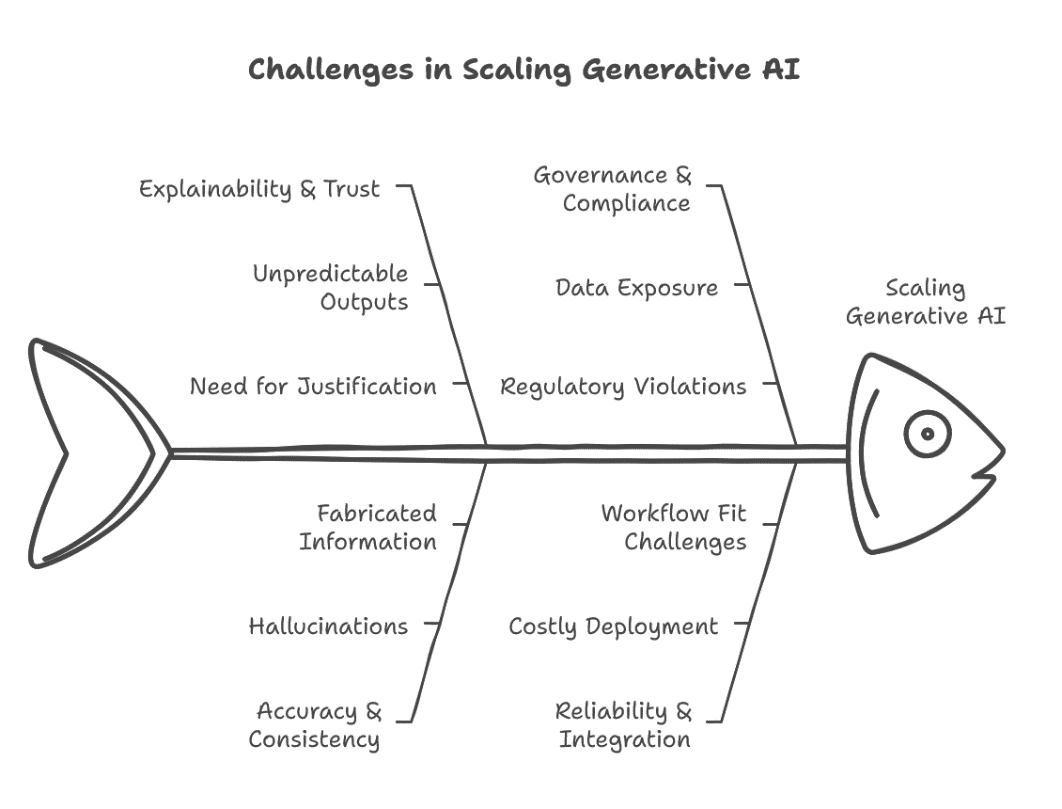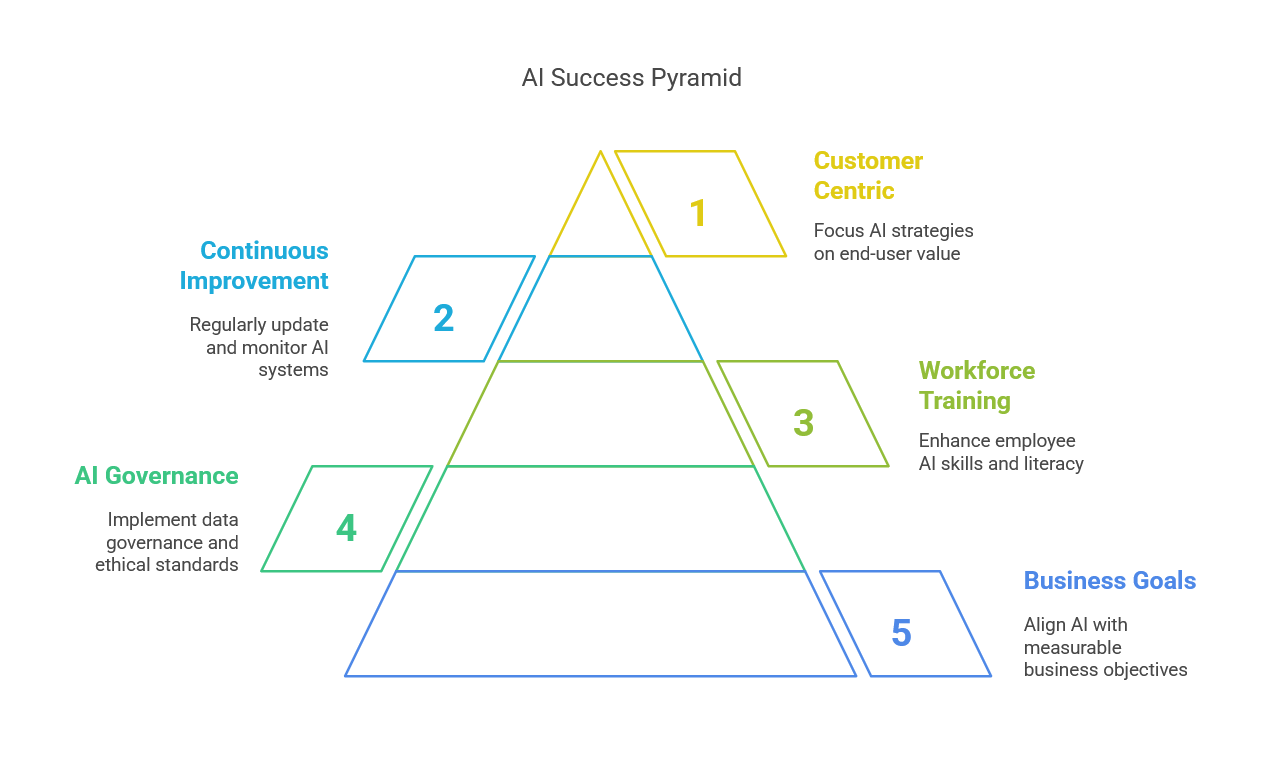

“The timeline for widespread enterprise adoption of AI will be slower than people think. A lot of lastmile issues need to be solved that aren’t obvious until you’re deep into them.â€
- Dylan Fox (Founder and CEO, AssemblyAI)
Generative AI is everywhere. It’s drafting emails, writing code, and summarizing meetings. Yet as Dylan Fox warns, the journey from pilot to production is rarely obvious from the start—and it’s precisely those hidden last‑mile challenges that slow adoption far more than hype suggests. Enterprises are eager to harness AI’s potential, but many find themselves stuck where AI needs to drive real business impact beyond just productivity gains. The big question: Can generative AI amplify revenue, or is it just an efficiency tool?
While companies have successfully piloted AI to automate tasks, scaling AI into monetizable, reliable solutions are another beast entirely. Many projects stall because they run into critical last-mile issues—explainability, consistency, governance, and compliance. These roadblocks aren’t obvious until businesses are deep into implementation, but they determine whether generative AI becomes a true business driver or just a flashy tool.
Let’s explore these challenges and how some industries are solving them.
Executives are now asking: Where are the actual dollars and new business coming from? While AI-driven efficiencies can cut costs, they have a ceiling. AI needs to generate revenue—through premium features, new products, or increased sales—if it’s to move beyond cost savings.
Gartner reports that nearly one-third of generative AI projects may be abandoned after pilots due to high costs and unclear business value. The problem? Most organizations rush to implement AI without a clear monetization strategy. They see some productivity improvements, but no tangible ROI.
- Explainability & Trust: Unlike deterministic AI, generative AI is unpredictable, making it difficult to explain its reasoning. Industries like finance and healthcare need models that provide clear justifications, not just plausible outputs.
- Accuracy & Consistency: AI models can hallucinate or produce inconsistent results, which is unacceptable in enterprise environments. Even AI-assisted legal filings have contained fabricated case citations, leading to real-world consequences.
- Governance & Compliance: Organizations struggle to ensure AI doesn’t expose sensitive data or violate industry regulations. Samsung banned employees from using ChatGPT after proprietary source code leaked through AI queries.
- Reliability & Integration: AI needs to seamlessly fit into workflows, but deploying it at scale is costly. Morgan Stanley spent months fine-tuning its GPT-4-powered assistant before releasing it to thousands of financial advisors.
- Rapid Pace of Model Evolution: Unlike traditional software releases, foundational generative AI models update almost weekly with new capabilities, architectures, and APIs. Each upgrade forces engineering teams into a cycle of re evaluation, prompt tuning, retraining, regression testing, and redeployment—dramatically lengthening development lifecycles and inflating operational costs. Executives then face a stark choice: adopt bleeding edge improvements at the risk of instability or delay until models mature, potentially ceding competitive advantage.

Each of these challenges represents a major hurdle in turning AI pilots into long-term, value-generating solutions. Now, let’s look at how different industries are grappling with these issues.
Finance was an early adopter of AI, leveraging it for risk assessment, fraud detection, and financial research. However, regulations make AI adoption complex. JPMorgan Chase, for example, restricted ChatGPT usage due to compliance risks.
Despite this, firms like Morgan Stanley have successfully integrated AI assistants that help financial advisors quickly retrieve vetted internal research. The key? Strict accuracy controls, explainability measures, and human oversight to ensure AI remains a trusted tool rather than a liability.
Generative AI is streamlining administrative tasks, summarizing medical notes, and assisting with patient communication. UC San Diego Health piloted AI-generated patient responses, finding they were often more empathetic than those written by doctors—though AI still required review to prevent errors.
Yet, the risks are high. A Mass General Brigham study found 7% of AI-generated medical responses contained potentially unsafe advice. This reinforces a crucial lesson: AI in healthcare should assist, not replace, human decision-making (at least for now).
Retailers are using AI for hyper-personalization, dynamic product recommendations, and content generation. CarMax used AI to summarize 100,000 customer reviews, significantly improving SEO and shopper experience. Meanwhile, Coca-Cola has experimented with AI-generated ad campaigns.
But AI isn’t always brand-safe. Levi’s faced backlash for using AI-generated fashion models instead of hiring real diverse talent. Retailers must balance efficiency with authenticity, ensuring AI-generated content aligns with brand values.
Manufacturers use AI to optimize product design, but last-mile challenges remain. Airbus leveraged AI to design a 45% lighter aircraft partition, reducing fuel consumption. However, the AI’s output required extensive real-world testing and 3D printing innovations before adoption.
The challenge? AI-generated designs often push the boundaries of traditional manufacturing. Companies must adapt production methods to fully realize AI’s potential, requiring investment beyond just the AI model itself.
Most enterprises have seen AI improve productivity—but few have successfully monetized it. Some studies show that only 15% of SaaS companies charging for AI features are seeing direct revenue growth.
Enterprises are now exploring strategies to turn generative AI into a profit center. Here are some examples which demonstrate that well‑integrated generative AI features can command higher price points, drive subscription upgrades, and materially accelerate top‑line growth — moving beyond mere cost savings into genuine revenue generation:
| Company | Industry | GenAI Powered Product | Monetization Model | Revenue Impact / ROI | Citation |
|---|---|---|---|---|---|
| Thomson Reuters | Legal / Professional Services | Co Counsel (GenAI legal assistant) | Premium subscription addon to Westlaw and Practical Law | Organic revenue growth forecast ↑7% in 2025 (driven by AI product adoption) | reuters.com |
| Duolingo | EdTech | Duolingo Max (GPT4 powered premium tier) | Freemium → subscription upgrade | 2025 revenue projected $962-978M; AI cited as key growth driver | reuters.com |
| Adobe | Creative / Marketing Software | Firefly / AI driven Experience Cloud | Premium AI SKUs & high erpriced tiers | Experience Cloud revenue +50% YoY (FY24); standalone AI ARR $125M (doubling target) | investors.com |
| Shopify | Ecommerce | Shopify Magic (AI product recommendations + content generation) | Subscription included features; higher merchant GMV | Q3 profit +45% to $459M; Q4 revenue +26% YoY ;AI cited as key growth driver | reuters.com |
| HubSpot | CRM / Marketing Automation | HubSpot AI (sales, marketing & service agents) | Tiered subscription; partner ecosystem fees | Q4'24 sales $703.2M (+21% YoY); fullyear' 24 revenue $2.99B (+21% YoY); AI cited as key growth driver | investors.com |
| Canva | SaaS (Design) | Magic Write + AI Assistant | Freemium → enterprise subscriptions | Annual revenue $2.5B; +75M ; AI cited as key growth driver | fastcompany.co |
Companies must approach AI like any product—with clear value metrics and pricing models. Free add-ons don’t sustain AI’s high operational costs.
1. Tie AI to Clear Business Goals
Ask: Will this AI feature increase revenue, reduce churn, or improve efficiency in measurable ways? Without clear KPIs, AI projects risk becoming expensive experiments.
2. Establish AI Governance Early
AI initiatives must include data governance, compliance reviews, and ethical guardrails. Samsung’s ChatGPT data leak is a cautionary tale of what happens without strong AI policies.
3. Train and Enable Your Workforce
AI adoption depends on employees. Invest in training and AI literacy, ensuring teams understand how to leverage AI effectively rather than fearing job displacement.
4. Plan for Continuous Improvement
AI isn’t set-it-and-forget-it. Monitor accuracy, user adoption, and business impact over time. Regular updates and refinements keep AI relevant and valuable.
5. Stay Ahead of the Curve
AI technology evolves rapidly. Executives must stay informed—watching industry trends, competitor moves, and new regulatory developments—to remain competitive.
6. Customer Centricity
The most successful AI monetization strategies, deliver tangible value to end users rather than just internal efficiencies.

The enterprise AI landscape is at a critical inflection point. While the initial wave of generative AI has demonstrated remarkable technological capabilities, the true test lies in bridging the last-mile gap between experimental pilots and revenue-generating products. As we've seen across industries, from finance to healthcare to retail, success depends not just on AI's raw capabilities, but on thoughtful implementation that addresses governance, reliability, and business alignment.
Organizations that approach AI strategically—with clear monetization paths, robust governance frameworks, and continuous improvement cycles—are beginning to reap substantial rewards. The data is clear: companies like Thomson Reuters, Duolingo, and Adobe aren't just saving costs; they're driving double-digit revenue growth through carefully designed AI products.
Yet as Dylan Fox wisely observed, the timeline for widespread adoption will be longer than many predict. The hype cycle inevitably gives way to implementation reality. Companies must now focus on solving those critical last-mile challenges—explainability, consistency, governance, and compliance—that determine whether AI remains a productivity tool or becomes a genuine business driver.
For executives navigating this landscape, the message is clear: generative AI's true potential lies beyond efficiency. By addressing the hidden complexities of enterprise-grade AI implementation, organizations can transform these powerful technologies from cost centers into engines of growth—bridging the gap between AI's promise and its profit.


